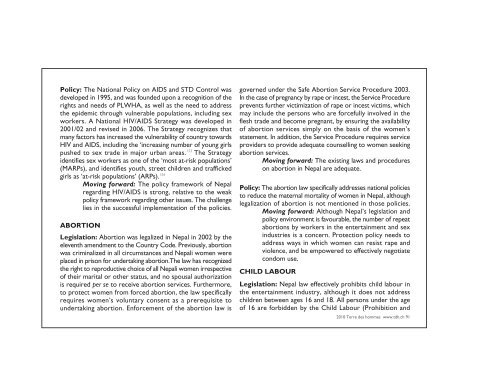View/save PDF version of this document - La Strada International
View/save PDF version of this document - La Strada International
View/save PDF version of this document - La Strada International
Create successful ePaper yourself
Turn your PDF publications into a flip-book with our unique Google optimized e-Paper software.
Policy: The National Policy on AIDS and STD Control was<br />
developed in 1995, and was founded upon a recognition <strong>of</strong> the<br />
rights and needs <strong>of</strong> PLWHA, as well as the need to address<br />
the epidemic through vulnerable populations, including sex<br />
workers. A National HIV/AIDS Strategy was developed in<br />
2001/02 and revised in 2006. The Strategy recognizes that<br />
many factors has increased the vulnerability <strong>of</strong> country towards<br />
HIV and AIDS, including the ‘increasing number <strong>of</strong> young girls<br />
pushed to sex trade in major urban areas. 155 The Strategy<br />
identifies sex workers as one <strong>of</strong> the ‘most at-risk populations’<br />
(MARPs), and identifies youth, street children and trafficked<br />
girls as ‘at-risk populations’ (ARPs). 156<br />
Moving forward: The policy framework <strong>of</strong> Nepal<br />
regarding HIV/AIDS is strong, relative to the weak<br />
policy framework regarding other issues. The challenge<br />
lies in the successful implementation <strong>of</strong> the policies.<br />
ABORTION<br />
Legislation: Abortion was legalized in Nepal in 2002 by the<br />
eleventh amendment to the Country Code. Previously, abortion<br />
was criminalized in all circumstances and Nepali women were<br />
placed in prison for undertaking abortion.The law has recognized<br />
the right to reproductive choice <strong>of</strong> all Nepali women irrespective<br />
<strong>of</strong> their marital or other status, and no spousal authorization<br />
is required per se to receive abortion services. Furthermore,<br />
to protect women from forced abortion, the law specifically<br />
requires women’s voluntary consent as a prerequisite to<br />
undertaking abortion. Enforcement <strong>of</strong> the abortion law is<br />
governed under the Safe Abortion Service Procedure 2003.<br />
In the case <strong>of</strong> pregnancy by rape or incest, the Service Procedure<br />
prevents further victimization <strong>of</strong> rape or incest victims, which<br />
may include the persons who are forcefully involved in the<br />
flesh trade and become pregnant, by ensuring the availability<br />
<strong>of</strong> abortion services simply on the basis <strong>of</strong> the women’s<br />
statement. In addition, the Service Procedure requires service<br />
providers to provide adequate counselling to women seeking<br />
abortion services.<br />
Moving forward: The existing laws and procedures<br />
on abortion in Nepal are adequate.<br />
Policy: The abortion law specifically addresses national policies<br />
to reduce the maternal mortality <strong>of</strong> women in Nepal, although<br />
legalization <strong>of</strong> abortion is not mentioned in those policies.<br />
Moving forward: Although Nepal’s legislation and<br />
policy environment is favourable, the number <strong>of</strong> repeat<br />
abortions by workers in the entertainment and sex<br />
industries is a concern. Protection policy needs to<br />
address ways in which women can resist rape and<br />
violence, and be empowered to effectively negotiate<br />
condom use.<br />
CHILD LABOUR<br />
Legislation: Nepal law effectively prohibits child labour in<br />
the entertainment industry, although it does not address<br />
children between ages 16 and 18. All persons under the age<br />
<strong>of</strong> 16 are forbidden by the Child <strong>La</strong>bour (Prohibition and<br />
2010 Terre des hommes www.tdh.ch 91
















